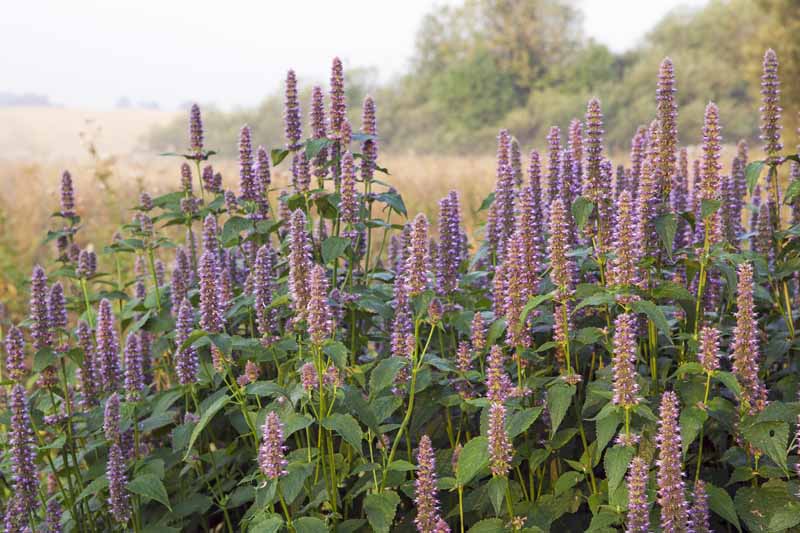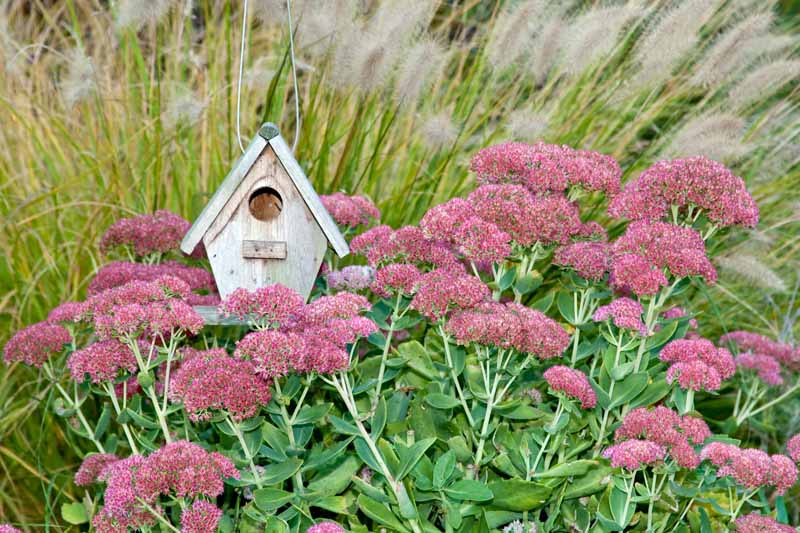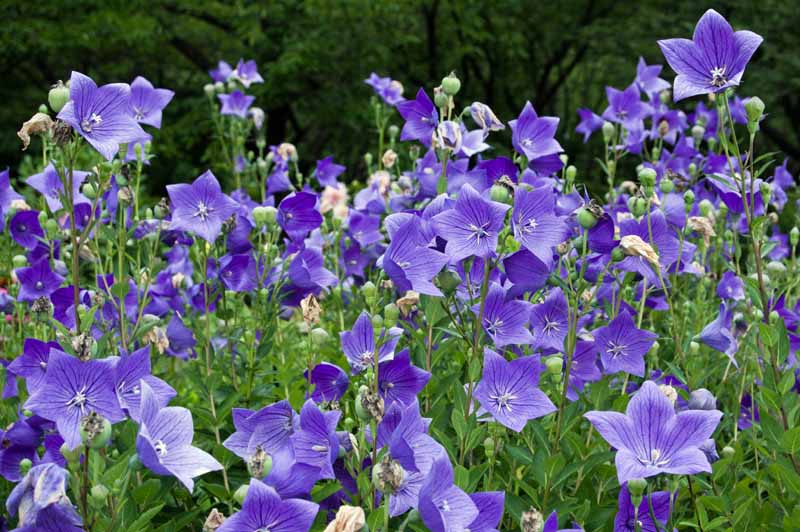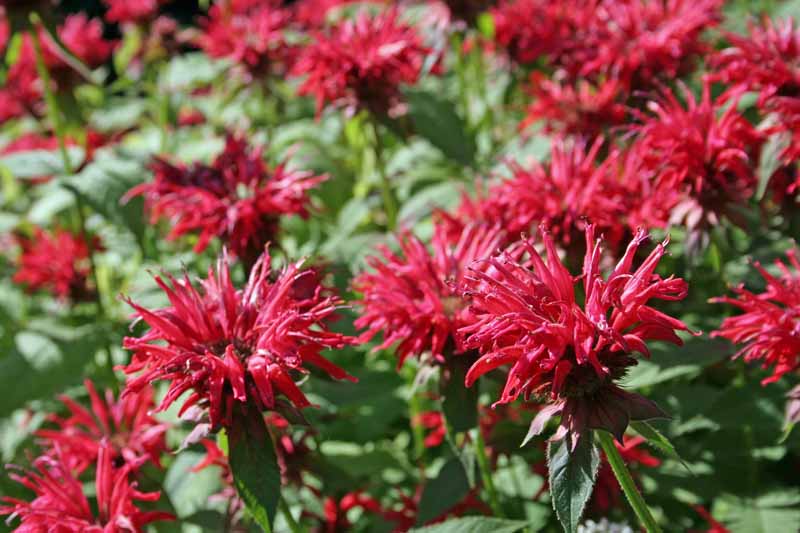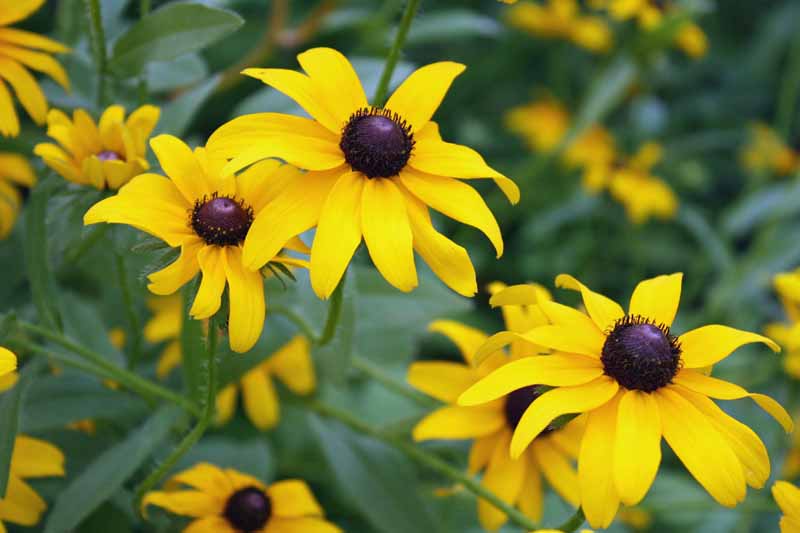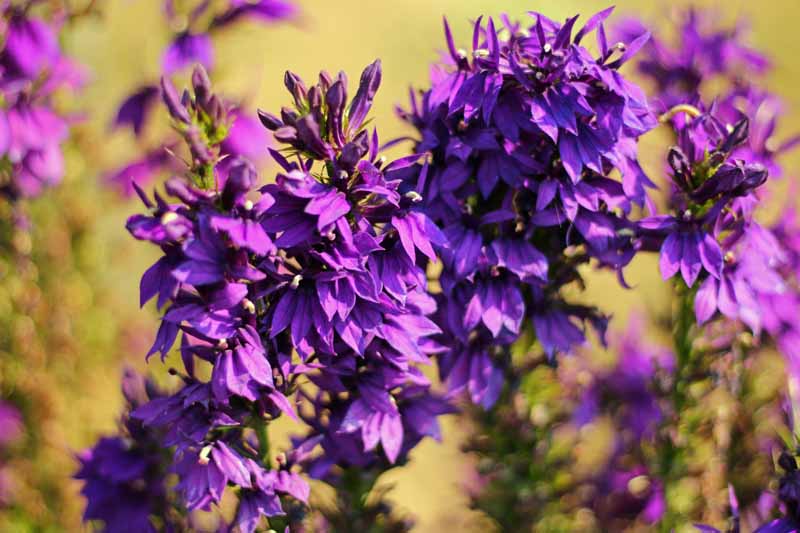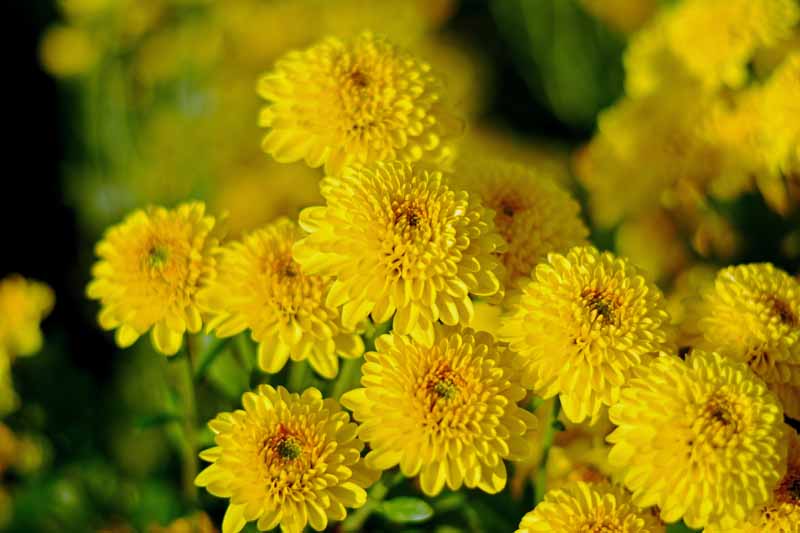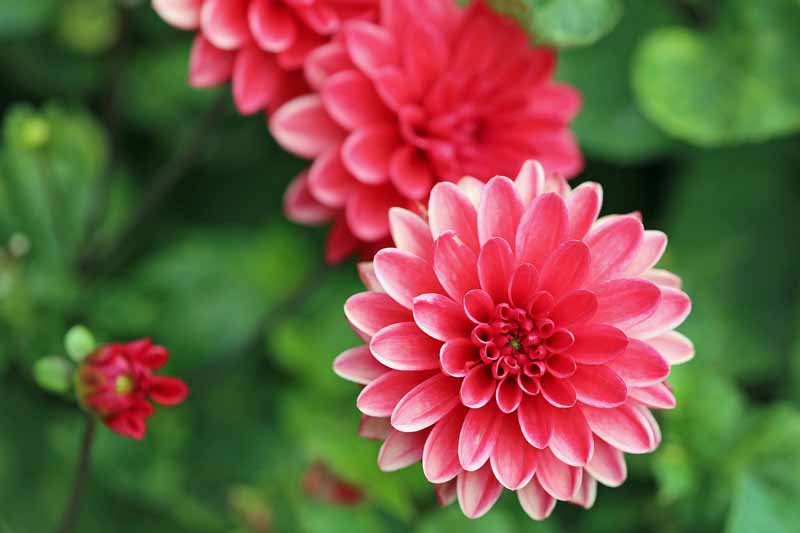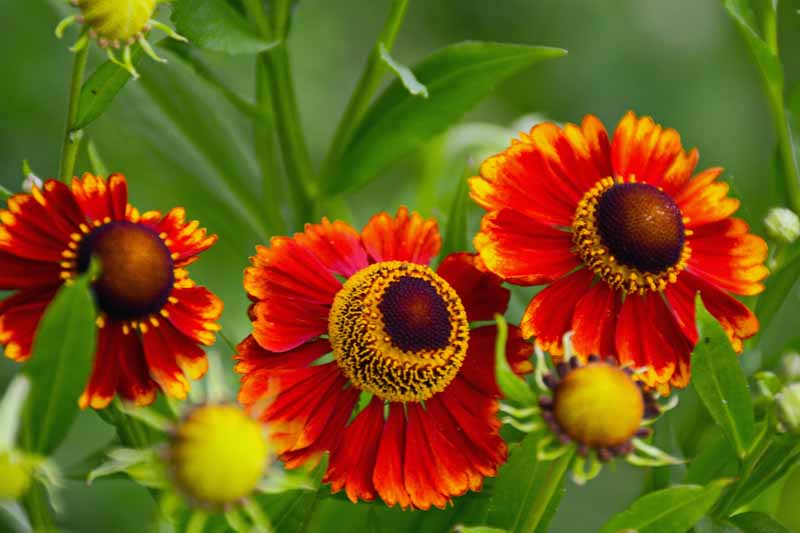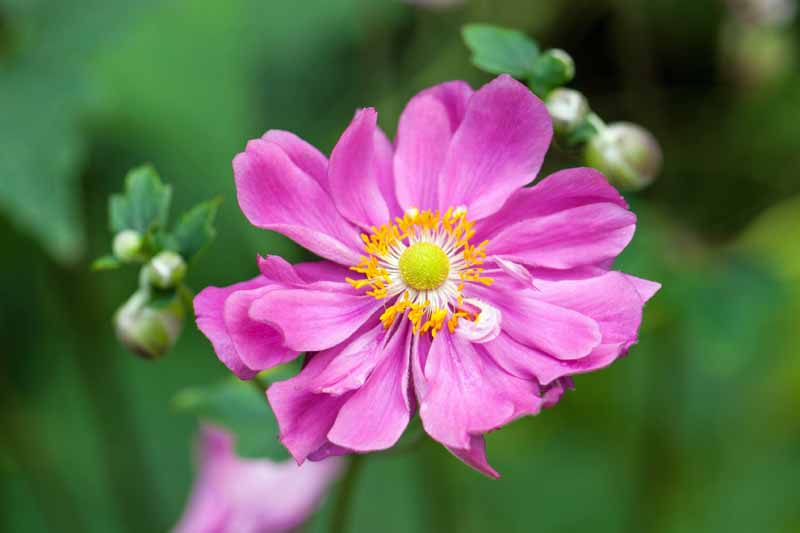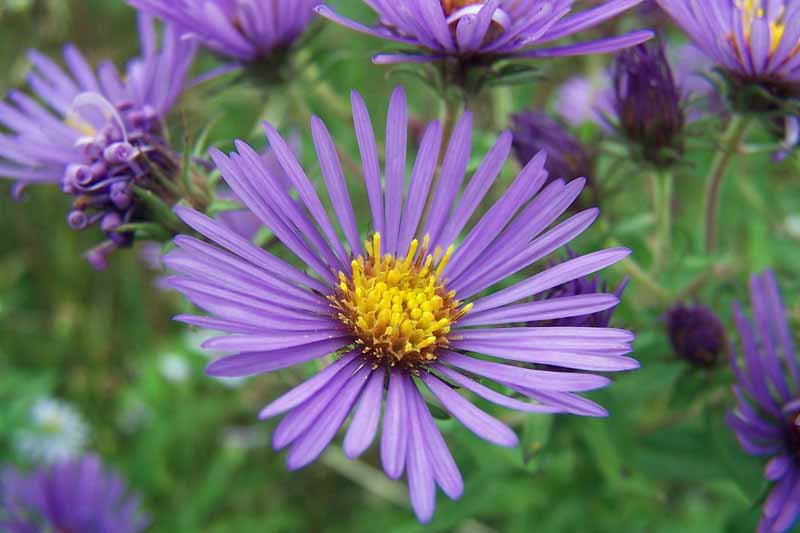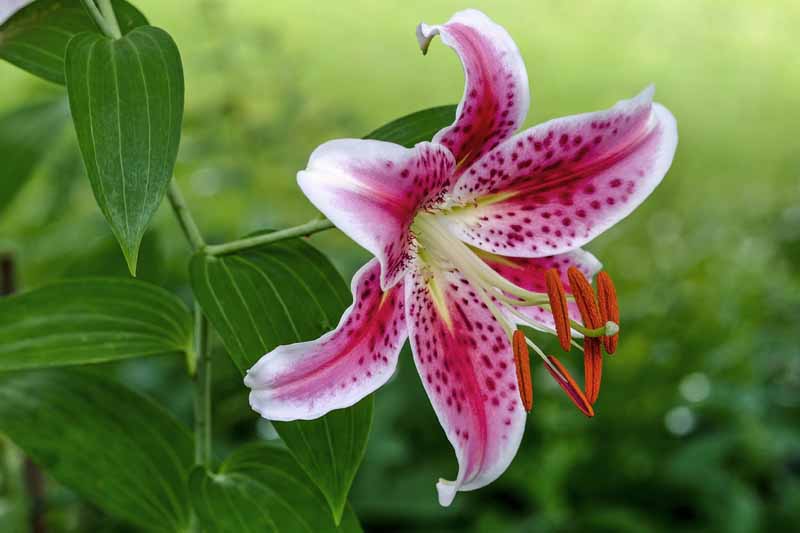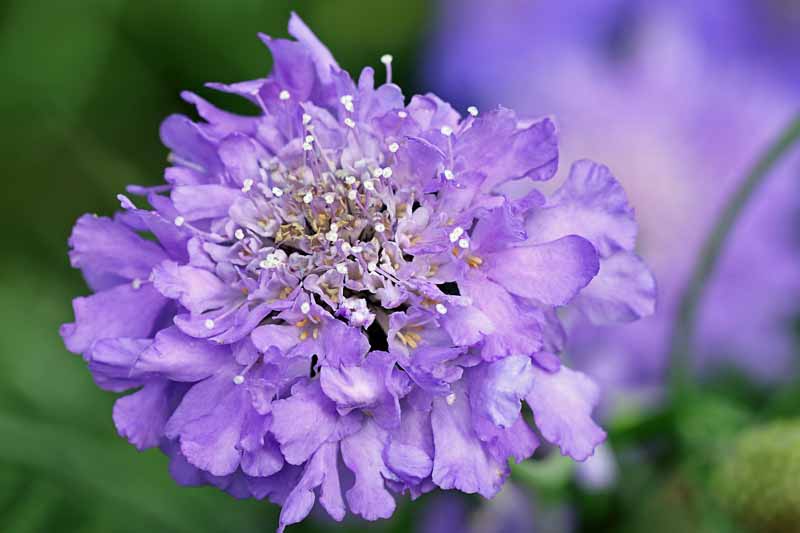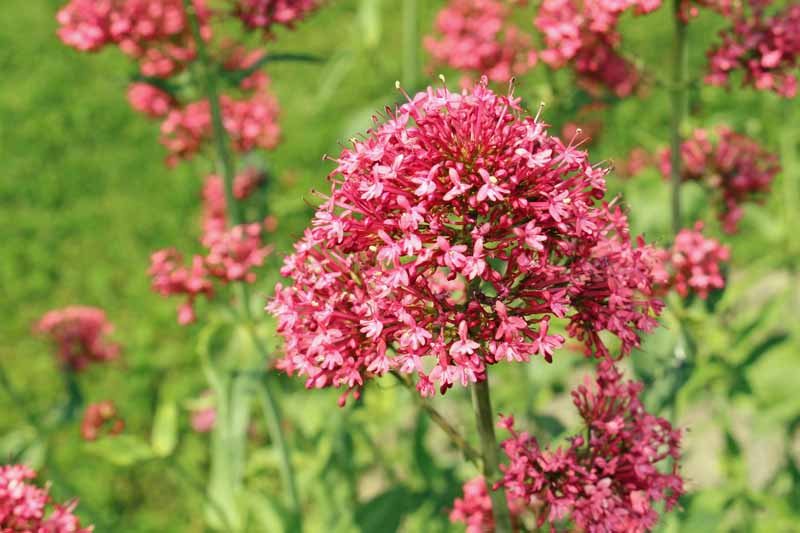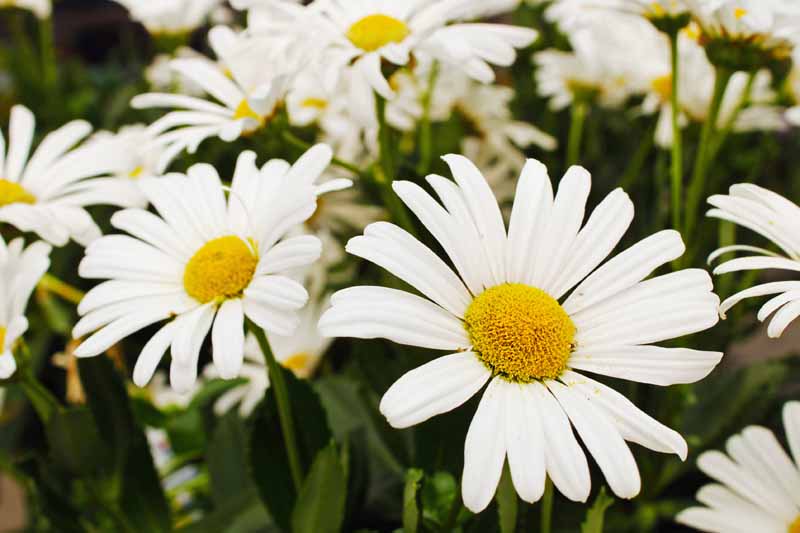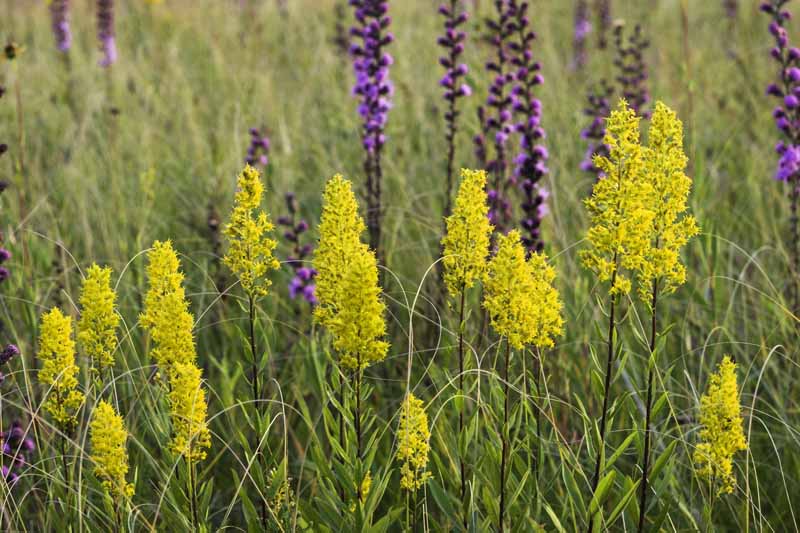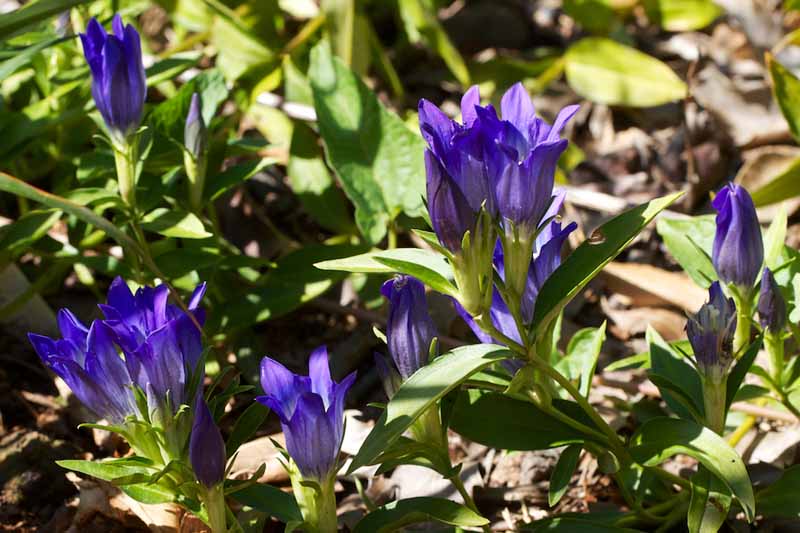We put in those long hours in early spring to prep, shop, and plant, and now it’s time to kick back and enjoy the season. The veggie patch yield is increasing daily, containers of annuals are established and thriving, and the perennial garden is… well, yikes, it looks kind of tired and needs some help! With hot, harsh sunlight and dry conditions, mid- to late summer can be tough on our gardens. Many plants suffer from heat stress and struggle without adequate moisture. We link to vendors to help you find relevant products. If you buy from one of our links, we may earn a commission. Many of these plants are North American natives, and others come from around globe – but all seem to flourish when the heat is on! Here’s 19 of our favorites, along with a brief description of the qualities we love about them.
1. Anise Hyssop (Agastachefoeniculum)
Anise hyssop, also known as butterfly mint, is a fragrant perennial with upright flower spikes that bloom from June to September. Traditional varieties have blue, lavender, or purple blooms, but new ones include bold colors such as orange and red.
Native to the plains and prairies of North America, anise hyssop is hardy in USDA Hardiness Zones 4-9. As a perennial, it spreads by rhizomes, and in colder climates it can be grown as a self-seeding annual. It grows easily in soil of average fertility, full sun, and medium to dry moisture conditions. Drought tolerant once established, it’s also deer and rabbit resistant – but very attractive to bees, butterflies, and hummingbirds. You can use cut flowers in fresh and dried arrangements, and the plants make attractive additions to beds and borders, butterfly, herb, and cottage gardens, or in naturalized settings like meadows or wildflower gardens. ‘Blue Boa’ is a superb performer, with masses of showy flowers, and plants are available through Nature Hills Nursery. Read more about growing anise hyssop here.
2. Autumn Joy Stonecrop (Hylotelephium ‘Herbstfreude’/Sedum spectabile ‘Autumn Joy’)
Blooming from August to October, ‘Autumn Joy’ stonecrop is a clump-forming herbaceous perennial with large, flat heads of tiny, rosy red flowers. Upright stems grow 18 inches to 2 feet tall with succulent, fleshy leaves. Buds first appear pink, change to red as they open, and finally turn a coppery shade as they die.
Stonecrop are drought-tolerant natives to Asia, Europe, and North America, hardy in Zones 3-8, and get their name from their habit of growing in stony ledges and rocky outcrops. ‘Autumn Joy’ prefers soil of average to poor fertility, dry to medium moisture, excellent drainage, and full sun. Attractive to bees and butterflies, ‘Autumn Joy’ can be used in the front of beds and borders, grown in alpine or rock gardens, planted en masse, or grown in containers. Left in place, they also add interest to fall and winter gardens. You can order 2-year old plants from Nature Hills Nursery. Or find tips on growing your own stonecrop flowers here.
3. Balloon Flower (Platycodon grandiflorus)
Balloon flower is an eye-catching, clump-forming perennial that gives a cheerful display of color to the late summer garden. Mature clumps grow from 1 to 2.5 feet tall, and young buds swell like balloons before bursting into bell-shaped flowers. Eye-catching in shades of blue, pale pink, and white, they flower from June to August.
A native to the slopes and meadows of East Asia, balloon flower is hardy in Zones 3-8 and enjoys a full to partial sun location. Aside from average soil and medium moisture requirements, it’s largely self-sufficient and requires little maintenance. Balloon flower also makes addition to the cutting garden, and it’s deer resistant as well. Use it to best effect in borders, containers, edging, and rockeries. ‘Astra Double Blue’ is a dwarf variety that blooms all summer and it can be ordered through Nature Hills. Read more about growing balloon flower here.
4. Bee Balm (Monarda didyma)
Bee balm, or wild bergamot, is a tall, attractive perennial with whorls of tubular flowers that add a bold punch of color to the late summer garden. Fragrant plants grow 2 to 4 feet tall with sassy, mop-top blossoms in colors of burgundy, lavender, pink, red, and white that bloom in July and August.
Hardy in Zones 3-9, it’s endemic to moist bottomlands, woods, and streambanks of eastern North America. Bee balm prefers humus-rich, well-draining soil with medium to wet moisture levels in a full to partial sun location. Deer and rabbit resistant, it’s attractive to bees, butterflies, and hummingbirds. Striking when massed in drifts, plant in borders, cottage and rain gardens, and in naturalized plantings. Burpee has a large selection of colorful bee balms for the garden. Read more about growing bee balm here.
5. Black-Eyed Susan (Rudbeckia hirta)
Black-eyed Susan is a cheerful wildflower renowned for its showy, daisy-like flowers in shades of orange, red, or sunshine yellow. Floret petals are anchored with a chocolate-brown center disk, and flowers bloom from June to September.
Indigenous to central and eastern North America, black-eyed Susans grow best in well-draining or sandy soil enriched with organic compost, medium moisture levels, and a full sun location. Drought resistant once established, they’re hardy in Zones 3-7 and grow from 1 to 3 feet tall. Perfect for the cutting garden, they’re deer resistant, attractive to butterflies, and small songbirds enjoy the seeds in fall. Use their bright color to best effect in beds and borders, cottage or wildflower gardens, large containers, or in mass plantings. Nature Hills Nursery has 2-year old plants of the foolproof ‘Goldstrum’ variety available or you can pick up traditional seeds through True Leaf Market. Read more about growing black-eyed Susans here.
6. Blue Cardinal Flower (Lobelia siphilitica)
Blue cardinal flower is a clump-forming, herbaceous perennial with stiff, unbranched stems 2 to 3 feet in height. The stems are topped with terminal racemes of tubular flowers in shades of light to dark blue that bloom from July to September.
Native to moist low meadows, woodlands, and stream and spring banks of central and eastern North America, it’s hardy in Zones 4-9. It requires a full sun to part shade site, humus-rich soil, and medium to wet moisture conditions. Deer resistant, blue cardinal flower is well-suited to beds and borders, rain gardens, perennial beds, native and woodland settings, and moist areas, like beside ponds or streams. ‘Great Blue’ has dense spikes of clear blue blossoms and can be purchased through Nature Hills.
7. Chrysanthemum (Chrysanthemum)
For reliable late season performance, chrysanthemums are available in a huge selection of colors, forms, and sizes. Blooming from August to November, flowers have ray florets, with numerous cultivars bred for multiple rows of florets in different shapes – from tubular to fringed. Colors are almost unlimited and come in shades of lavender, orange, red, white, and yellow.
A native of China, this herbaceous perennial has been cultivated for millennia. It grows best in fertile, humus-rich and well-draining soil, with consistent moisture and full sun exposure. Hardy in Zones 5-9, mums appreciate a winter mulch in colder regions. Chrysanthemums attract butterflies, and are deer and rabbit resistant. They are most effective in mass plantings, at the front of mixed and perennial beds and borders, and in containers or windowboxes. Check out Burpee’s online selection of bright, reliable garden mums or read more about growing chrysanthemum here.
8. Dahlia (Dahlia)
Dahlias are tuberous rooted perennials with a large variety of colors, shapes, and sizes ranging from 1 to 6 feet tall. They flower from July to September. The pinwheel-shaped blossoms are categorized into 10 different groups to distinguish among the many flower types, such as cactus, decorative, pompon, and waterlily. Sizes vary greatly as well, from compact patio cultivars to ones with huge, dinner-plate-sized blooms.
Native to Mexico and Central America, dahlias are hardy in Zones 8-11. In colder regions, the tubers need to be dug up in the fall and stored, then planted in the spring and grown as annuals. Dahlias enjoy full sun with some afternoon shade in hot regions. Plant in well-draining, compost-rich soil, with a medium moisture level. Dahlias make an outstanding option for cut arrangements, and are well-suited for beds, borders, containers, and window boxes. You can find a large selection of colors and shapes at Burpee or read more about growing dahlias here.
9. Echinacea / Coneflower (Echinacea purpurea)
Echinacea, also called coneflower, is a clump-forming perennial with purple, daisy-like flowers that put on a showy display from June to September. It grows 2 to 5 feet tall and reblooms readily, with blossoms forming on stiff, multi-branched stems clad with broad, dark green leaves.
Indigenous to eastern North America, echinacea is hardy in Zones 3-9 and easily grown in well-draining soil of average fertility, dry to medium moisture, and a full to part sun location. However, this plant is wonderfully adaptable and tolerant of harsh conditions, including drought, heat, humidity, and poor soil. Echinacea is a good choice for freshly cut or dried flowers. Deer and rabbit resistant, it’s also attractive to butterflies and other beneficial creepy-crawlies, and migrating songbirds will visit seedheads in fall and winter. It makes an attractive addition in mixed and perennial beds and borders as well as native or naturalized areas, and is stunning when planted in masses with yellow black-eyed Susans. Check out the many juicy echinacea colors available from Burpee or read more about growing echinacea here.
10. Helenium (Helenium autumnale)
If it’s vibrant, warm colors you want, helenium produces masses of daisy-like blooms in rich shades of orange, red, and yellow. Sun lovers, these erect, clump-forming plants that are also known as sneezeweed grow 3 to 4 feet tall, adding terrific interest from August to October.
Native to Central and North America, helenium grows best in soil of average fertility amended with organic material, medium to wet moisture, and full sun. Hardy in Zones 3-8, it is intolerant of dry soils. It also benefits from being cut back in late spring to encourage branching and more flowers. Helenium attracts butterflies, and winter birds enjoy the seedheads, but deer avoid it. Use it in mixed and perennial beds and borders, cottage gardens, naturalized areas, and in areas with moist soil. Burpee offers three options in their ‘Pinwheel Collection,’ in glorious colors of copper, gold, orange, red, and yellow.
11. Japanese Anemone (Anemone hupehensis)
Japanese anemones have delightful cupped blooms of silvery pink or white petals, with a dense ring of yellow stamens that add elegant, swaying charm to the late summer garden. Borne on tall, stately stems, they grow 2 to 4 feet tall, and bloom from August to October.
Native to central China, they’re hardy in zones 4-8. They do best in well-draining, cool, rich soil and will enjoy a mulch of shredded leaves or compost. Plant in full to partial sun and provide medium moisture. Japanese anemones are particularly effective when mass planted, and are well suited to perennial beds, cottage and woodland gardens, or naturalized settings. Burpee has bare root plants available in either white (‘Honorine Jobert’) or pink (‘September Charm’). Read more about growing Japanese anemones here.
12. Joe-Pye Weed (Eutrochium purpureum)
Joe-pye weed is an erect, clump-forming perennial with handsome burgundy/green foliage and large, showy heads of pink, mauve, or purple flowers. Growing 3 to 7 feet tall, it blooms from July to October and has a sweet, vanilla-like fragrance.
Native to central and eastern North America, it’s easily grown in fertile, humus-rich soil with medium to wet moisture conditions, in a full to partial sun location. It’s not a fan of heavy shade. Joe-pye weed is attractive to butterflies and is well-suited to moist borders, cottage gardens, meadows, rain gardens, and locations along streambanks or beside ponds. For a compact size, try ‘Little Joe,’ Eutrochium dubium. It has a lovely fragrance and splendid mauve color. This cultivar is available online from Burpee. Read more about growing joe-pye weed here.
13. New England Aster (Symphyotrichum novae-angliae)
New England aster, sometimes referred to as Michaelmas daisy, is a reliable perennial with bright daisy-like flowers that bloom from June to October, or whenever heavy frosts set in. Upright, multibranched stems form dense mounds of lilac, rose, deep purple, or white blooms that will grow 1 to 7 feet tall.
Indigenous to North America east of the Rockies, these fall beauties are hardy in Zones 3-8 and thrive in full to partial sun, with average soil and moisture. They require good drainage. Once established, New England aster is very low-maintenance. It’s deer resistant and drought tolerant as well. Nectar rich, they’re also extremely attractive to butterflies. Migrating monarchs love them for a quick energy boost on their journey south. They make a long-lasting cut flower and are well-suited to mixed and perennial beds and borders, or massed in drifts in naturalized settings. Eden Brothers offers New England aster seed packets or once ounce sachets. Read more about growing New England aster here.
14. Oriental Lily (Lilium orientalis)
Oriental lilies make a stunning statement with their large, star-shaped flowers that sit atop thick stalks with dark green, strappy leaves. Growing 3 to 6 feet tall, they’re renowned for their intense fragrance and striking recurve petals. Blossoms of cream, orange, pink, red, rose, white, and yellow are often adorned with speckles and stripes.
A clump-forming hybrid bulb, this is typically the last of the lilium family to flower, blooming in July and August. Hardy in Zones 3-9, Oriental lilies enjoy a compost or humus-rich soil, acidic to neutral pH levels, average moisture, good drainage, and full sun. These exotic-looking gems make a superb, long-lasting option for cut arrangements, and are a must-have for the cutting garden. They also work well in containers, cottage and courtyard gardens, and mixed or perennial beds. Check out the selection of spectacular Oriental lily bulbs at Burpee.
15. Pincushion Flower (Scabiosa)
Pincushion flower is a clump-forming perennial that grows 12 to 18 inches tall and supplies plenty of old-fashioned charm. Frilly flowers with a domed center disc sit atop stiff stems and bloom in colors of blue, lavender, pink, and white from May until frost.
Scabiosa get their common name from their showy blossoms, which resemble pincushions stuffed with pins. Hardy in Zones 5-9, they’re native to Africa, Asia, and Europe. They can’t abide wet feet, particularly in winter, and need well-draining soil of average fertility, medium moisture levels, and a full sun location. They make a lovely option for bouquets and arrangements, are deer and drought resistant, and are a favorite of butterflies. With a relatively short growth habit, pincushion flower works well planted en masse as an edging plant, in the front of beds and borders, and in containers or windowboxes. Burpee has a good selection available in shades of blue, lavender, pink, orange, and white.
16. Red Valerian (Centranthus ruber)
Red valerian features showy clusters of fragrant, tiny, trumpet-shaped blooms in shades of pink to carmine with fleshy blue-green leaves. Growing 18 inches to 3 feet on mostly upright stems, it blooms from May to September.
Native to the Mediterranean region, red valerian performs well even in poor, dry soils – although it will struggle in high heat and humidity. It prefers sandy, well-draining soil of average fertility, medium moisture, and a full sun location. It’s well suited to borders, cottage gardens, and naturalized areas. It also makes an effective bank or ground cover, and can be used to combat erosion.
17. Shasta Daisy (Leucanthemum × superbum)
Cheerful white flowers highlight the hybrid Shasta daisy. A clump-forming herbaceous perennial, blossoms are formed from pretty ray florets radiating from a sunshine-yellow center disk. Borne on tall stalks of 2 to 3 feet in height, they bloom from July to September.
The Shasta daisy is non-fussy and easily grown in soil of average fertility, with dry to medium moisture levels, and a full sun location. Good drainage is a must, and they’ll tolerate some light afternoon shade in hot climates or when growing in dry soil. Shastas attract butterflies, and they’re deer and rabbit resistant as well as drought tolerant. With a long-lasting bloom period, they’re effective in cottage and cutting gardens, mixed and perennial beds, and containers. Burpee has plenty of Shastas to choose from or you can learn more about growing them here.
18. Showy Goldenrod (Solidago speciosa)
The bright yellow color of goldenrod will burnish your late summer garden with beautiful clusters of small, densely packed flowers. Stiff, narrow stems grow upright in clumps 2 to 3 feet tall with flowers blooming from July to September.
Goldenrods are native to central and eastern North America, including Mexico, and showy goldenrod is a heat- and drought-tolerant perennial that’s hardy in Zones 3-9. It’s easily grown in full sun with well-draining soil of average fertility and dry to medium amounts of moisture. Attractive to bees and butterflies, showy goldenrod adds bright color to perennial beds, and any naturalized setting like meadows or prairie and wildflower gardens. Order 3-packs of showy goldenrod from Nature Hills Nursery. Read about growing goldenrod flowers here.
19. True Blue Gentian (Gentiana x intermedia ‘True Blue’)
For a splash of intense blue, blue gentian grows 2 to 3 feet high in a dense, upright mound with shiny green leaves. Buds open to tubular flowers of brilliant electric blue, covering the multi-branched flower stems from July to October. A perennial to alpine environments in temperate regions around the world, it’s hardy in Zones 4-8. ‘True Blue’ does best in moderately fertile soil, requires medium to wet moisture levels and good drainage, and prefers full to part-sun locations. Attractive to bees, butterflies, and hummingbirds, it’s also deer and rabbit resistant. Use as an eye-catching addition to beds, borders, containers, and path edging.
The Finest for Late Summer Color
Whether your garden is wet or dry, sunny or shady, there are plants to add plenty of color and pretty flowers to the dog days of summer. Now that you know about these 19 fabulous perennials, are there any spots in your garden that could use their help? We also think you’ll enjoy:
17 Temperate Flowering Perennials That Will Grow Almost Anywhere The 15 Best Annuals for Late Summer Color The 15 Best Perennials for Fall Color
Photos by Lorna Kring © Ask the Experts, LLC. ALL RIGHTS RESERVED. See our TOS for more details. Product images via Burpee and True Leaf Market. Uncredited photos: Shutterstock.


